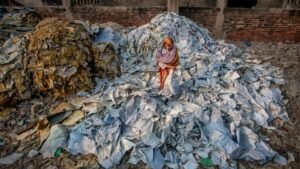The fashion industry — especially fast fashion — has long been under scrutiny for its environmental and ethical impacts. Today, one of its most pressing challenges is textile waste. With the rise of fast, disposable clothing trends, the world is facing an alarming surge in garment waste that many brands are struggling to manage.
📉 The Scale of the Problem
Globally, the fashion industry produces over 100 billion garments every year. A staggering portion of these clothes ends up in landfills within just a few months of purchase. In the U.S. alone, an estimated 11 million tons of textile waste are discarded annually.
This waste comes from:
-
Overproduction: Brands often make more than they can sell to stay ahead of demand.
-
Returns: Many returned items aren’t resold and instead are discarded.
-
Low-quality materials: Cheap, synthetic fabrics degrade quickly and are difficult to recycle.
-
Seasonal turnover: Rapid trend cycles encourage consumers to buy more, wear less, and toss faster.
🧵 How Does Fast Fashion Respond?
Despite mounting pressure, fast fashion brands often rely on short-term fixes rather than systemic changes. Here’s how the industry typically deals with textile waste:
1. Donation and Resale
Some brands donate unsold clothes to charities or resell through outlet stores. However, donation systems are overburdened, and not all garments find a second home — many still end up in overseas landfills or are incinerated.
2. Recycling Programs
Retailers like H&M and Zara have launched in-store recycling programs, encouraging customers to return used clothes for discounts. While well-intentioned, these programs have limitations:
-
Only a small fraction of collected garments are recycled.
-
Most recycling focuses on downcycling (turning clothes into rags or insulation) rather than regenerating new textiles.
3. Burning Unsold Inventory
Some companies have admitted to incinerating unsold clothes to protect brand exclusivity or avoid the costs of redistribution. This controversial practice contributes to air pollution and squanders resources used in production.
4. Marketing Sustainability Without Structural Change
Fast fashion is quick to highlight “green” capsule collections or recycled materials, but these often represent a tiny sliver of total production. Critics call this greenwashing — marketing a sustainable image without making impactful changes to production models.
✅ What Needs to Change?
Real responsibility will require more than recycling bins and PR campaigns. Here’s what meaningful progress looks like:
-
Designing for durability and recyclability
-
Shifting to slower production models
-
Investing in fiber-to-fiber recycling technology
-
Transparent supply chains and material sourcing
-
Extended producer responsibility (EPR) laws that make brands accountable for their products’ end-of-life
👕 Consumer Power
While the system needs reform from the top, consumers also play a role. Choosing quality over quantity, supporting ethical brands, and buying secondhand are small but powerful acts.
🌱 Final Thought
Fashion should be about expression, not exploitation — of people or the planet. As the fast fashion industry races to keep up with trends, it must also catch up with its responsibility to the environment. Until then, the mountains of textile waste will keep growing.

